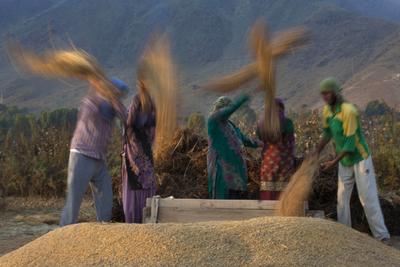It all depends on the behaviour of India’s inflation in the coming months. The battle against inflation has been a long one, starting back in 2006. The average annual rate of inflation since this time has remained high, at about 7 per cent on the wholesale price index and 9 per cent on the consumer price index. For India though, inflation has always been associated with high food prices. Therefore, the only durable way to bring down inflation is to contain rising food prices.
India’s rising food prices are caused by both demand and supply factors. As per capita income rises, so too does the demand for food. With higher incomes, the consumption basket has expanded from carbohydrates to include more vitamin- and protein-rich foods. Real per capita income in India rose by 4 per cent per annum in the 1990s, and by 6 per cent in the 2000s. But output per capita of cereals, pulses, oilseeds and sugarcane either stagnated or increased only marginally during this period. Output per capita of vegetables, fruits, milk, fish, meat and poultry increased in India, though not as much as the rise in per capita income. So, there has been a widening demand-supply gap in the country that has led to high food inflation, barring the period between 2000 and 2006.
In a free market system, a price rise elicits greater supply, eventually leading back to a fall in prices. But this has not happened in India because the country has an extremely distorted food market. The hand of the government is everywhere — ostensibly to protect the farmer and the consumer from ‘exploitative’ middlemen. But acute government intervention has resulted in the opposite, suffocating the farmer on the one hand, and hurting the consumer through high prices, on the other.
The current system neglects farmers in many ways. It denies the farmer a clear price signal that could lead them to produce different crops. Although the government announces minimum support prices for various crops, it buys only paddy and wheat at this price for the purpose of feeding its mammoth public distribution system. Minimum support prices have risen by 12.5 per cent per annum for paddy and 10.3 per cent for wheat over the last six years. Such large hikes in procurement prices combined with the government’s massive stockpiling have become the major causes of India’s high food inflation.
Instead of an open, free market, India possesses a ‘subsidy-control regime’. The government hands out subsidies through free or cheap water, electricity and fertilisers. This has had a huge negative impact on ground-water levels, soil fertility and production efficiency for both inputs and outputs in agriculture. Subsidies are also offered to consumers through the low price of cereals distributed through government ration shops. Government control is exercised in the marketing of agricultural produce as well. Very little reform has taken place in agricultural produce marketing committee (APMC) regulation, which orders the sale of agricultural commodities through government-regulated markets called the mandis. The monopsonistic mandis have exploited farmers through the large number of intermediaries that are part of the process. These include commission agents, wholesalers and sub-wholesalers, and their opaque methods of weighing and pricing, commissions, taxes and produce payments.
A ‘root and branch’ reform of India’s food markets is badly needed. This would allow Indian farmers to produce enough goods and bridge the rising demand–supply gap that lies behind India’s persistent inflation.
The reforms should start with a revamp of government procurement processes and the public distribution system. While food subsidies cannot be stopped, they should only be distributed in the form of direct cash transfers, and not through low food prices. The system of minimum support pricing is fine but should work purely to support farmers during price collapses, and must be de-linked from the procurement process, which should be at market price. Input subsidies to farmers should also be administered through cash transfers rather than low pricing of agricultural inputs, and directed towards small-scale farmers. Simultaneously, the price of fertilisers, water and electricity should be decontrolled.
Farmers have to be given the freedom to sell their products either in mandis or to private retailers. This requires drastic changes in APMC legislation. Recent retail liberalisation latched with onerous conditions will not really help, and there should be free inter-state movement of agricultural products, an abolition of the central sales tax, and a more liberal trade-licensing scheme for both domestic and foreign retailers.
India cannot resume high growth without taming inflation — but to do that, it has to free its food markets through radical reform. Failing to do so will mean the Indian economy slips back to the bitter years of the 1970s, when high inflation was coupled with very low growth.
Mathew Joseph is professor of economics at FORE School of Management, New Delhi.
A version of this article was first published here in the Financial Express.

